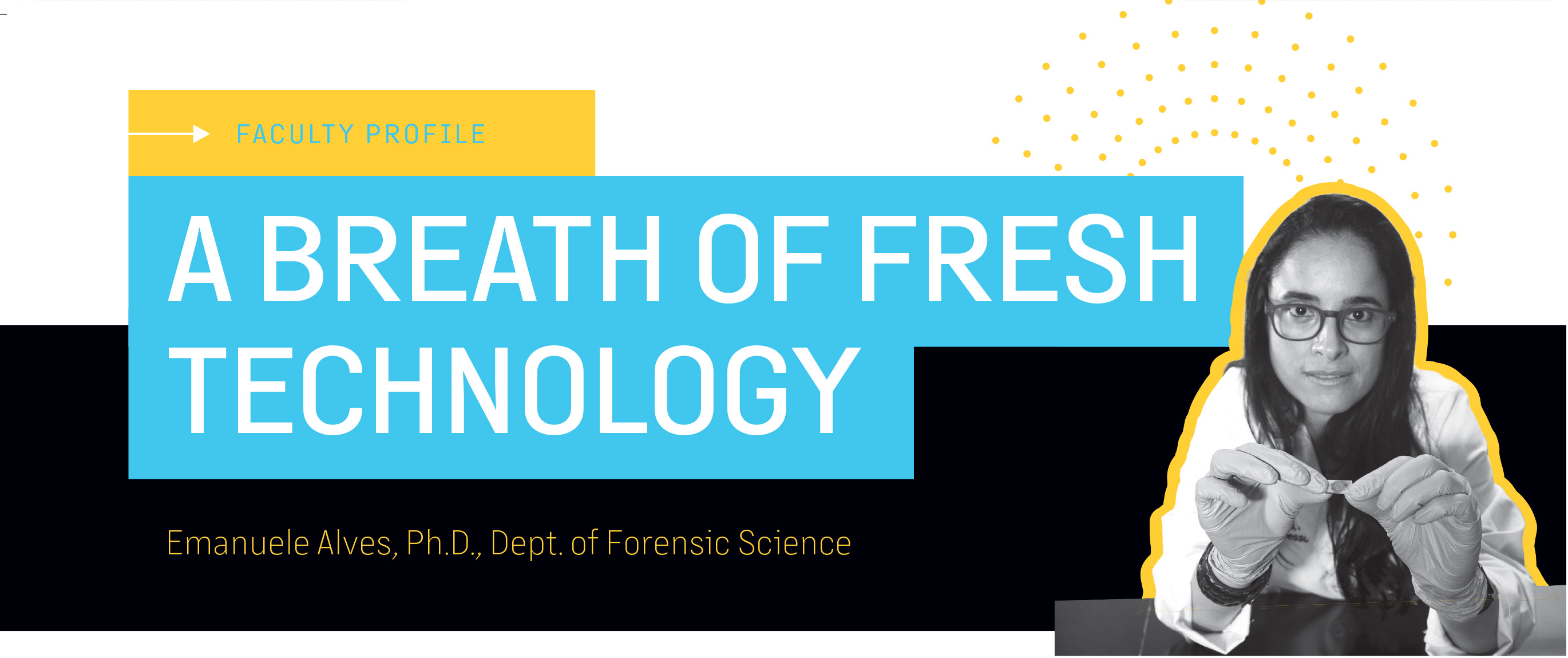
A breath of fresh technology
With a goal of increasing road safety, Emanuele Alves, Ph.D., is working to develop a faster, more effective breathalyzer for THC, the component of cannabis most associated with its psychoactive effects.
While alcohol breathalyzers offer results within minutes, the THC breathalyzers now on the market have to be sent to a lab for testing, which can take hours. With funding from the Justice Department, a team led by Alves, an assistant professor in the Department of Forensic Science, hopes to create a device that allows testing in the moment — it would yield results within minutes, and it could differentiate between THC and CBD, leading to fewer false-positive results for THC.
“With this approach, we could reduce the number of accidents caused by impaired drivers, making roads safer for all of us,” Alves said. “When a device like this is public, drivers know that they can be caught using marijuana, and this could act as a deterrent for people considering using marijuana before getting behind the wheel. This is a similar effect to alcohol breathalyzers, which have been shown to deter drunk driving.”
Alves first saw the importance of impairment monitoring systems in her earlier work for a variety of entities and agencies, including the Rio de Janeiro State Police in Brazil. As a forensic toxicologist, she conducted testing to identify drugs, chemicals and toxins to determine their potential eff ect on an individual’s death, illness or mental or physical impairment.
“I kept thinking about how many lives were lost due to driving under the influence of drugs,” Alves said. “Alcohol was the main reason for many years. I have several projects in my lab at VCU dedicated to opioids — my main research substance group — but it was impossible for me to ignore the increasing presence of marijuana cases. It started to call my attention to, how could we try to make the roads safer?”
Alves and her team began studying current THC detection devices and found that they don’t provide a readout of how much THC is in someone’s system. Instead, they are collection devices that need to be sent to a lab for analysis. That’s when they got to thinking about breathalyzers.
“Breathalyzers are a fast, practical and reliable tool for impairment monitoring on the road,” Alves said.
Alcohol breathalyzers use electrochemical reactions to detect alcohol on the breath when a person exhales. Other researchers are exploring how to use this method to detect cannabis use faster. The challenge, however, is that the electrochemical reaction that occurs in this method isn’t specific to THC. An electrochemical reaction would simply detect the presence of cannabis — it can’t tell whether the substance is CBD or its psychoactive cousin, THC.
“Our idea is to create a colorimetric-based device where the reaction between THC and a specifi c dye occurs inside the device, leading to the formation of intense color,” Alves said. “Due to the nature of these reactions, the color intensity is directly proportional to the concentration of the substance we’re looking for — in this case, THC.”
With Alves’ team’s test, people who are using CBD, which is legal in many states, wouldn’t blow a false positive for THC like they might with a device that’s based on an alcohol breathalyzer. For the device they are currently developing, the colorimetric test would only change color if THC is present.
“Our ultimate goal is to be able to have this device available for broad use in two years. Having a device that gives a faster result would help to improve and establish policies to regulate the use of cannabis and driving, giving the population the information needed to keep our roads safe,” said Alves. “This is not about whether to use or not to use cannabis products, but to create in the population the consciousness of the risks associated with driving under the influence of THC.”